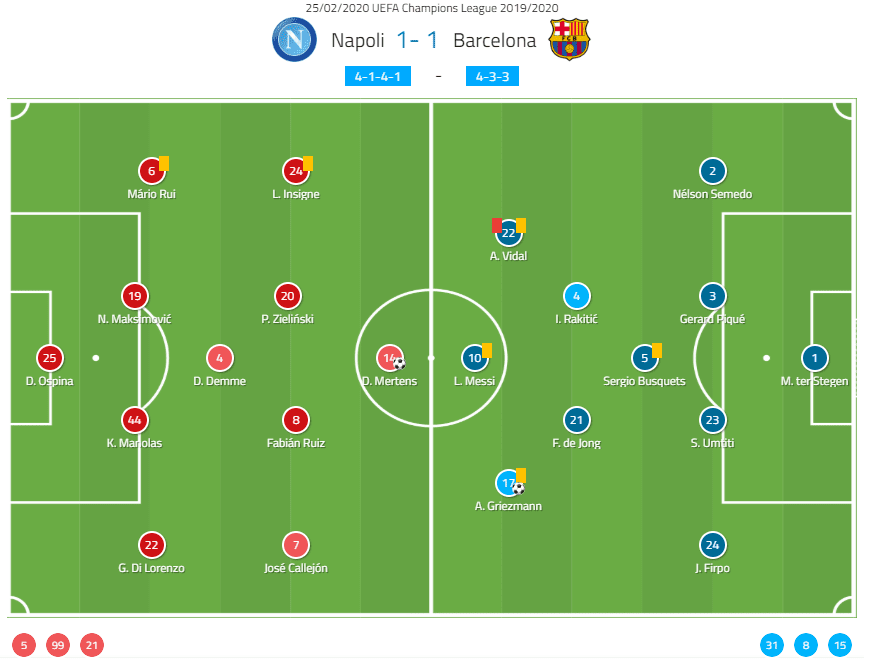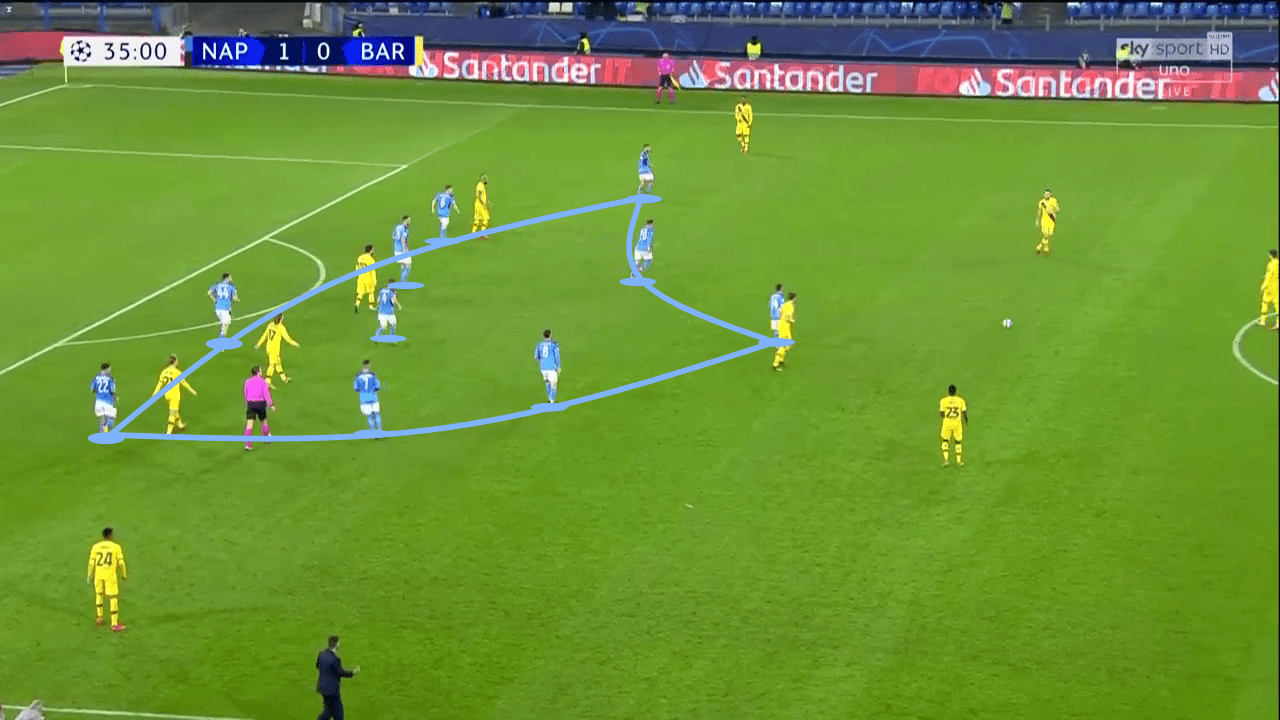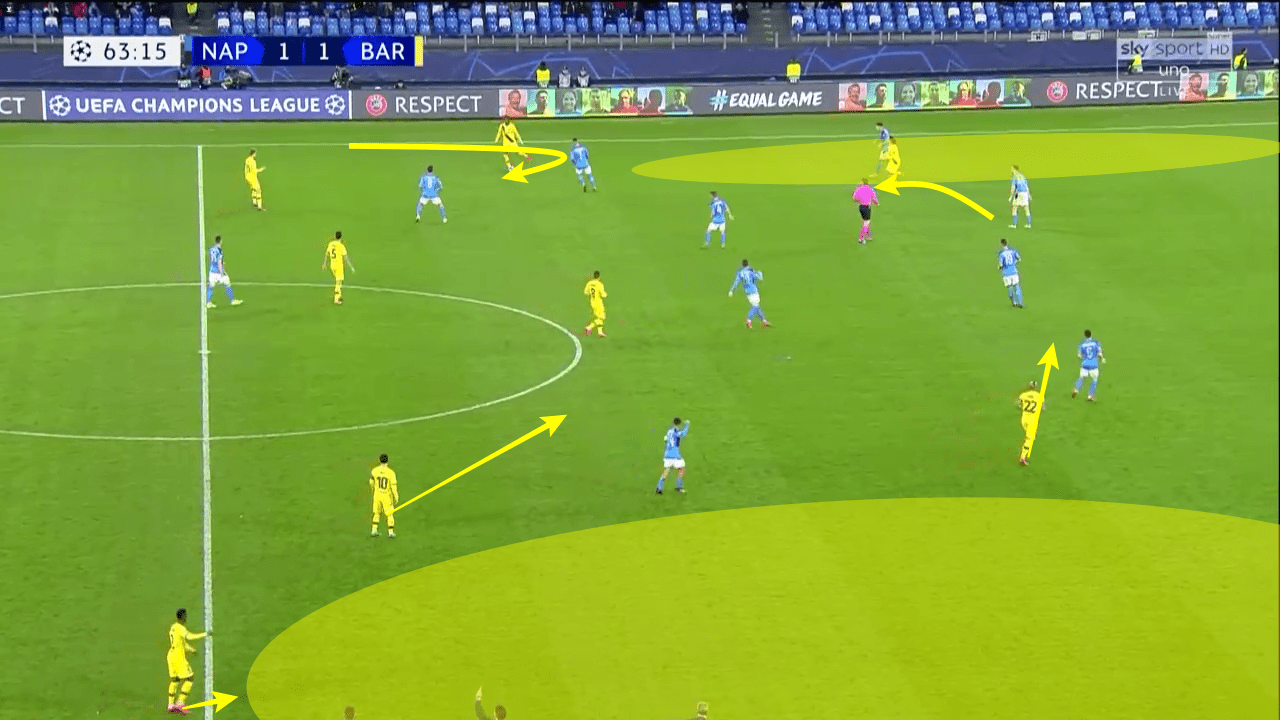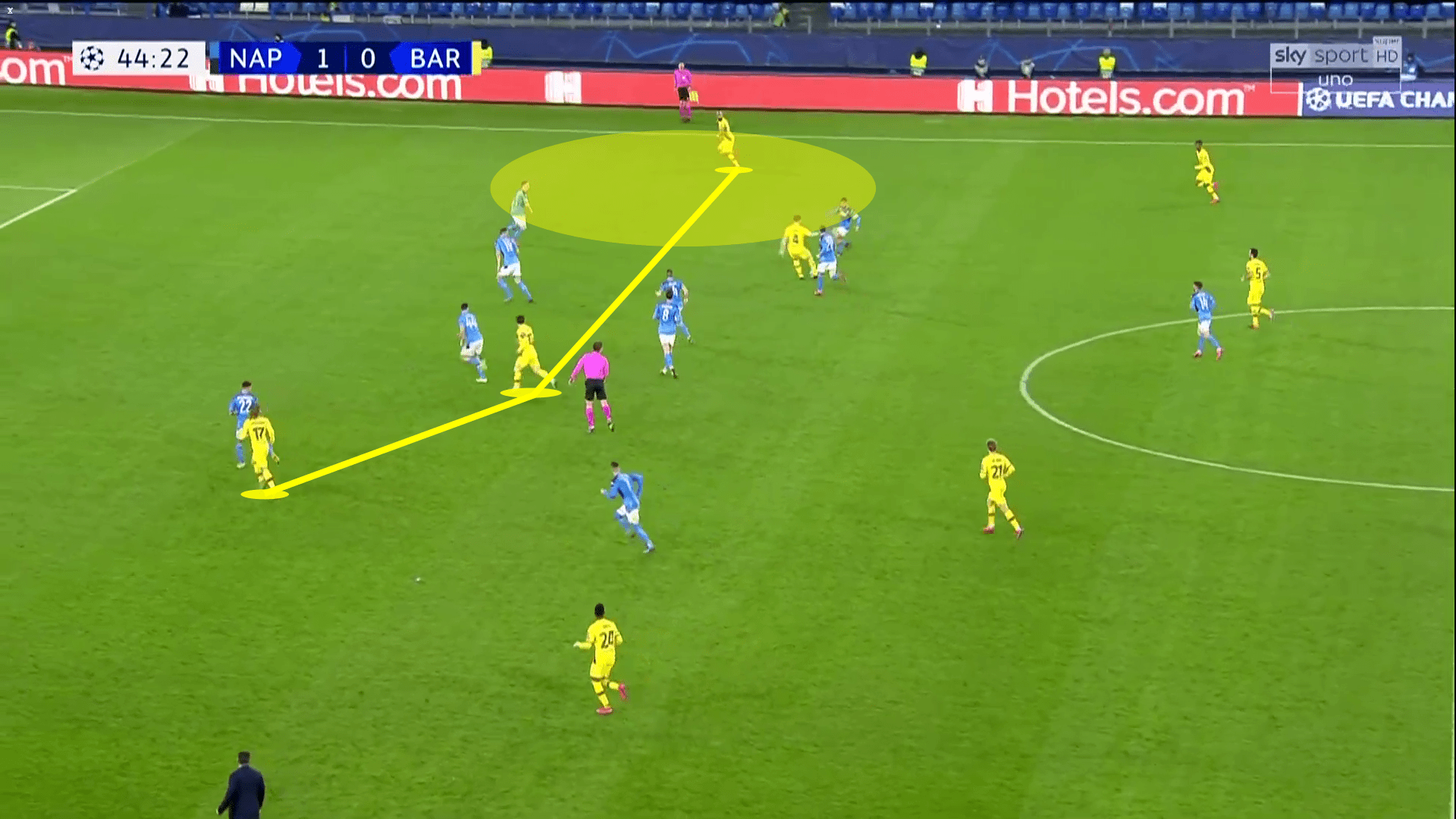The Champions League last 16 pitted a Napoli side struggling domestically against a Barcelona team who had just returned to the top of La Liga. With the first leg taking place at the Stadio San Paolo.
Dries Mertens opened the scoring on the half hour mark, breaking down the Barcelona defence with a brilliant finish which left Marc-Andre Ter Stegen with no chance. The Catalans fought back but struggled to break down their Serie A counterparts, having to wait until Antoine Griezmann found space in the box to equalise with a near post tap in to make it 1-1 in the second half.
This tactical analysis will consider the tactics of both Napoli coach Gennaro Gattuso and Barcelona boss Quique Setién. The analysis will consider the approach of Napoli and Barcelona as they played out an intriguing tactical battle in this draw.
Line-ups

Napoli fielded a similar line-up to their recent outings in Serie A, with Piotr Zielinski replacing Elif Elmas in midfield and José Callejón coming in for Matteo Politano. It formed part of their approach of converting their traditional 4-3-3 into a more defensive minded 4-5-1, with Lorenzo Insigne and Callejón sitting deeper, rather than alongside Mertens in attack.
Barcelona also made changes, with Arturo Vidal preferred on the right to Ansu Fati, allowing Ivan Rakitić to come into the team in the middle. Samuel Umtiti was also, somewhat surprisingly, picked ahead of Clement Lenglet in defence.
Napoli’s defensive structure
At the heart of this result is the plain and simple fact that Napoli shut Barcelona out defensively and the visitors could not find a way through. Their structure allowed them to use a 4-5-1 when defending in a low block which could easily convert into a 4-3-3 to provide more of a press on Barcelona as they entered the final third. Gattuso had clearly tracked Barcelona’s performances under Setién and noted that they are keen to retain possession, as reflected by their 64.34% possession in this tie. The Italians were happy to allow them to do that as they simply could not find a way through and instead passed the ball laterally, with 10% fewer forward passes than their season average and a 19.6% increase in backwards passes and a 37.7% increase in lateral passes.
Napoli sat deep with their back four supported by Diego Demme who would drop in as a third central defender when needed. Keeping a narrow shape, they congested the middle of the park and made it difficult for Barcelona, and in particular Lionel Messi, to find space to exploit and roam free. When he did, he was often finding himself taking on four or five men at a time. He completed four dribbles, even in these circumstances, out of 10, producing his lowest completion rate in any of his last 10 games and his sixth lowest figure for the season. Napoli not only denied Barcelona space, but they took Messi out of the equation as best as possible too.

The crucial role was also played by Insigne, Mertens and Callejón. Unlike their team-mates, they did not sit particularly deep and instead would each look to press as the ball transitioned into their channel. That was an essential element in Gattuso’s gameplan to keep Barcelona at bay and make life more difficult for them as they looked to identify spaces and move the ball into the final third, particularly out wide.
Barcelona’s lack of width
Whilst Napoli’s defensive structure is to be commended, Barcelona didn’t help themselves either. Setién’s decision to drop Fati in favour of Vidal on the right in particular played into the trap of restricting his team’s width. Napoli’s narrow set-up could have allowed Barcelona to exploit the spaces down the wings but they failed to capitalise. Through a combination of a lack of width in attack and midfield and disappointing performances from the team’s full-backs, Barcelona ended up being drawn into central areas which Napoli were only too happy to play in.
As can be seen in this image below, Griezmann’s movement was often too slow and not wide enough. Junior Firpo at left-back was not daring enough and would often turn back on himself at the first sign of being pressed. Nelson Semedo on the opposite flank was better, providing a third of his team’s crosses, but even he was too slow to make the run down the wing into the space provided by Messi and Vidal, who both drifted centrally and often found themselves treading on each other’s toes.

Semedo’s performance was the only hope of any width coming from Barcelona and led to an unbalanced approach where Junior Firpo on the opposite flank contributed little. Of 49 positional attacks, just 4 came through the left flank. He may be a substitute for Jordi Alba during his injury absence, but it must be clear for Barcelona that he restricts their approach without offering more offensive play, something which he did far more effectively whilst with Real Betis last season.
Vidal’s forward role
The surprise of the night was to see Vidal return to the right-wing role which he had previously featured in only briefly for Barcelona. Before the match, Setién and his staff had spent plenty of time talking up the Chilean and his importance to the side, bringing in a fighting spirit which was absent elsewhere. His role was to add more flexibility, allowing Barcelona to be more resolute defensively and a typical approach to be used away from home in order to ensure that there was sufficient cover. Equally, this may have been with the yellow card suspension risk hanging over Semedo and Sergio Busquets. By placing Vidal on the right, he could handle such risky scenarios and look to reduce the risk of either of those duo from being booked.
The greatest issue with this set-up is that as a natural central midfielder, he tends to drop deep and to the right, just like Messi does. With Semedo also looking to push on, this led to congestion in that area of the field, with Messi, Vidal and Semedo all looking to occupy the same area of the field. Meanwhile, Griezmann was left isolated and lost floating in between a left-wing and central position which he struggled to dominate as he was marked so closely by the Napoli defence. This imbalance linked in hand-in-hand with the way in which Barcelona struggled to exploit the flanks where Napoli were most vulnerable.

When Barcelona needed width the most, he lacked both the instinct and the pace to create chances. As can be seen above, he did occasionally find space out wide and look to take advantage, but he lacked the pace and drive of a player like Fati who could run at the full-back and put Napoli on edge. Such a lack of penetration was what only served to fuel the number of backwards and sideways passes, Vidal only registering seven forward passes all game, half of his season average.
What’s more is that Vidal’s indiscipline was also on show, picking up two yellow cards for one incident late on for a needlessly late and reckless challenge which saw him then square up to Mário Rui and see a second yellow. Rather than protecting Semedo and Busquets, the latter of whom was booked anyway, he only added to the selection headache that Setién will face for the return fixture.
Conclusion
With tough La Liga fixtures coming up, including the Clásico against Real Madrid, this draw was not a damaging one for Setién’s Barcelona and they can be happy with the away goal. Napoli defended superbly, something which will be more challenging should Setién be less conservative in his team selection at Camp Nou for the second leg. Gattuso’s set-up worked perfectly and it will now be down to Setién to work on how his side can exploit those wide areas and become more dynamic in order to break down the defensive structure. With limited midfield options, that will be no easy task.





Comments